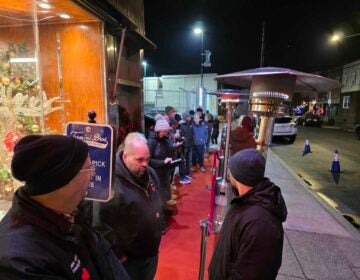Cliveden criticized for firing expert on its slaveholding past
This week, Cliveden unveiled its plan to reinvent itself in light of a troubling discovery.
The historic home of the Chew family, and site of the Battle of Germantown, has been grappling for several years with the emergence of papers that show the family was active in the slave trade.
Unsettling past, unresolved future
That legacy continued to be unsettling on Tuesday. Even as Cliveden officials gave what they hoped would be an exciting explanation of their new direction for the site, their plans were disrupted by a protest over the firing of a curator who’d been a key architect of the project.
David Young, Cliveden’s executive director, hopes to transform the National Trust property from a static house museum and Revolutionary War re-enactment site into an interactive space that encourages visitors to have a candid dialogue about the painful parts of Cliveden’s past, as well as the inspiring ones.
For years, Young has worked closely with the curator he has now fired, Philip Seitz, on efforts to engage the surrounding community, which is significantly African-American, in dialogue and education about the role of slavery and race not only in Cliveden’s history, but Germantown’s as well. In that effort, they worked with community members, scholars and a number of community groups.
Several of these past participants interrupted proceedings to protest Seitz’s firing, then stalked out.
“We stand in opposition to Phillip’s removal,” said Atiba Kwesi of And Justice for All, a prisoners’ rights group.
Racial healing in question
Kwesi and a member of the National Coalition of Blacks for Reparations in America, Ari Merretazon, said they fear Young and the Cliveden board are backing away from a memorandum of understanding with N’COBRA that called for extensive community dialogue focussed on racial healing as a form of reparations for Cliveden’s ties to the slave trade.
Merretazon said he understood the project to be anchored in that community work, not primarily in the changes to Cliveden’s exhibits. To him, Tuesday’s announcement seemed to narrow unacceptably the scope of the effort.
Young said he remains committed to the memorandum of understanding, but added that he felt compelled to fire Seitz because “he did no want to go forward in the direction we are going.”
A former Cliveden employee, John Reese, also spoke up in support of Seitz.
“I can’t see, in all honesty, how this project can go forward,” he said. “That man studied this stuff for 10 years.”
After Kwesi, Merretazon and Reese walked out with two other men who expressed similar concerns over the new direction, they were followed by Jude Ray, an artist who has chronicled a year of community dialogues that Cliveden convened as part of its effort to grapple with the Chew slave-trading legacy. She tried to persuade the three men that the spirit of the project was intact, despite Seitz’s ouster.
“There were three black men that stood up for this white man,” Merretazon responded to her. “Can you understand that?”
Young acknowledged that Seitz’s passion for this project will be missed: “He was a significant contributor.” But Young wanted to focus on moving forward with the plan, not the protests.
“It’s very easy to leave the discussion,” he said. The harder part is hanging in and making compromises, according to Young.
A plan for Cliveden’s future
Before the protest, both Ray and Cliveden board members Mary DeNadai expressed enthusiasm for Young’s plans.
“This is a kind of amazing moment in the history of the project,” Ray said.
“I can speak for the National Trust,” DeNadai said. “This is one of the most exciting undertakings of all of the National Trust’s 28 projects.”
The Cliveden staff and board want to take the following steps:
Transform the barn and kitchen spaces into interactive experiences that focus on the stories of African Americans.
Interpret exhibits in light of the slavery context, for example showing the slave labor that went into building the house’s famed furniture.
Make clear that the Chews were not alone in building privilege on top of an exploitative system.
Extend an active welcome to the immediate community to visit Cliveden.
Make sure not to restrict the intended audience of the new exhibits to African Americans, but present them to all Americans.
Still, the explanation was light on terms like “racial healing” and “reparations,” which Young as well as Seitz have used in the past to explain Cliveden’s new mission.
By day’s end, DeNadai, the board member, was clearly taken aback by the furor over Seitz’s firing.
“It’s a very difficult situation,” she said.
WHYY is your source for fact-based, in-depth journalism and information. As a nonprofit organization, we rely on financial support from readers like you. Please give today.



